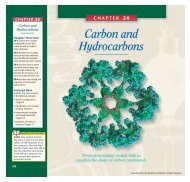You also want an ePaper? Increase the reach of your titles
YUMPU automatically turns print PDFs into web optimized ePapers that Google loves.
source, <strong>with</strong> a balloon placed over the opening of the flask. As the flask sits<br />
over the burner, the temperature of the air inside it increases from T 1 to T 2.<br />
According to the ideal gas law, when the temperature increases, either the pressure<br />
or the volume—or both—must also increase. Thus, the air inside the flask<br />
exerts a pressure (P 2) on the balloon that serves to inflate the balloon. Because<br />
the flask is not completely closed, the air expands to a larger volume (V 2) to fill<br />
the balloon. When the flask is taken off the burner, the pressure, volume, and<br />
temperature of the air inside will slowly return to their initial states.<br />
Another alternative form of the ideal gas law indicates the law’s dependence<br />
on mass density. Assuming each particle in the gas has a mass m, the total mass<br />
of the gas is N × m = M. The ideal gas law can then be written as follows:<br />
Ideal Gas Law<br />
MATERIALS<br />
✔ 1 plastic 1 L bottle<br />
✔ 1 quarter<br />
PV = NkBT = ⎯ Mk<br />
⎯<br />
BT<br />
m<br />
P = ⎯ Mk<br />
⎯<br />
BT<br />
=<br />
mV<br />
⎯M ⎯ ⎯k<br />
BT rk<br />
⎯ = ⎯<br />
BT<br />
⎯<br />
V m m<br />
A real gas can often be modeled as an ideal gas<br />
An ideal gas is defined as a gas whose behavior is accurately described by the<br />
ideal gas law. Although no real gas obeys the ideal gas law exactly for all temperatures<br />
and pressures, the ideal gas law holds for a broad range of physical<br />
conditions for all gases. The behavior of real gases departs from the behavior of<br />
an ideal gas at high pressures or low temperatures, conditions under which the<br />
gas nearly liquefies. However, when a real gas has a relatively high temperature<br />
and a relatively low pressure, such as at room temperature and atmospheric<br />
pressure, its behavior approximates that of an ideal gas.<br />
For problems involving the motion of fluids, we have assumed that all gases<br />
and liquids are ideal fluids. Recall that an ideal fluid is a liquid or gas that is<br />
assumed to be incompressible. This is usually a good assumption because it is<br />
difficult to compress a fluid—even a gas—when it is not confined to a container.<br />
A fluid will tend to flow under the action of a force, changing its shape<br />
while maintaining a constant volume, rather than compress.<br />
Copyright © by Holt, Rinehart and Winston. All rights reserved.<br />
Make sure the bottle is empty, and<br />
remove the cap. Place the bottle in the<br />
freezer for at least 10 min. Wet the quarter<br />
<strong>with</strong> water, and place the quarter over<br />
the bottle’s opening as you take the bottle<br />
out of the freezer. Set the bottle on a<br />
nearby tabletop; then observe the bottle<br />
and quarter while the air in the bottle<br />
warms up. As the air inside the bottle<br />
A third way of writing the ideal gas<br />
law may be familiar to you from<br />
your study of chemistry:<br />
PV = nRT<br />
In this equation, n is the number of<br />
moles of gas (one mole is equal to<br />
6.02 × 10 23 particles). The quantity<br />
R is a number called the molar (universal)<br />
gas constant and has a value<br />
of 8.3 1 J/(mol•K).<br />
NSTA<br />
TOPIC: Gas laws<br />
GO TO: www.scilinks.org<br />
sciLINKS CODE: HF2095<br />
begins to return to room temperature, the<br />
quarter begins to jiggle around on top of<br />
the bottle. What does this movement tell<br />
you about the pressure and volume inside<br />
the bottle? What causes this increase in<br />
pressure and volume? Hypothesize as to<br />
why you need to wet the quarter before<br />
placing it on top of the bottle.<br />
<strong>Fluid</strong> <strong>Mechanics</strong><br />
339<br />
SECTION 9-4<br />
Teaching Tip<br />
Point out that the n in PV = nRT<br />
and the N in PV = Nk BT are<br />
related through Avogadro’s number<br />
(the same remark applies to<br />
R and k B).<br />
Key Models and<br />
Analogies<br />
Graphs offer a convenient way to<br />
represent the relationship<br />
between temperature, volume,<br />
and pressure for the following<br />
special cases of the ideal gas law:<br />
P<br />
V<br />
P<br />
Constant T<br />
Constant P<br />
Constant V<br />
TEACHER’S NOTES<br />
This activity is meant to demonstrate<br />
that pressure increases <strong>with</strong><br />
temperature when the volume of<br />
a gas is constant. Eventually, the<br />
pressure becomes great enough<br />
to overcome the weight of the<br />
quarter, and it jumps up slightly,<br />
allowing air to escape.<br />
V<br />
T<br />
T<br />
339
















